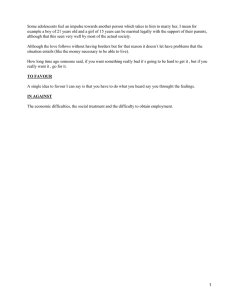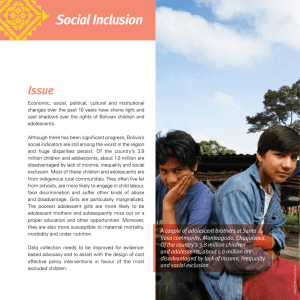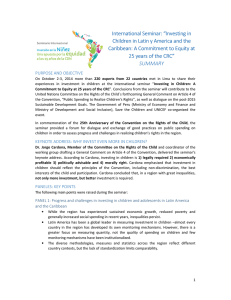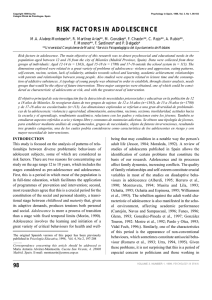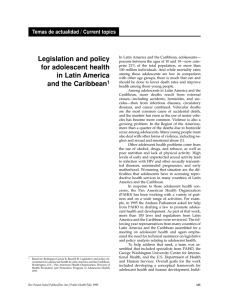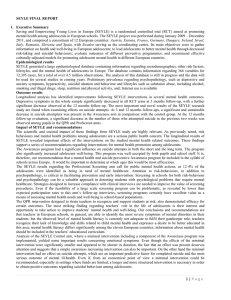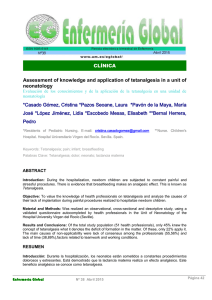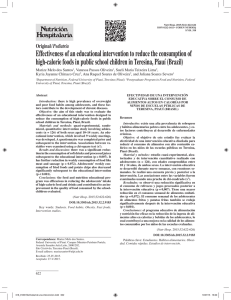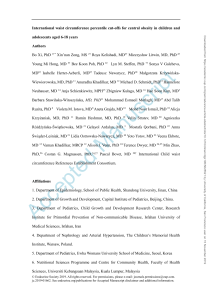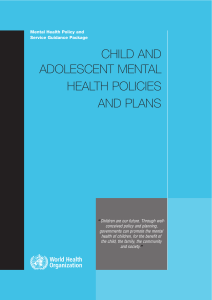Adolescents` social networks: The influence of friendship on the
Anuncio
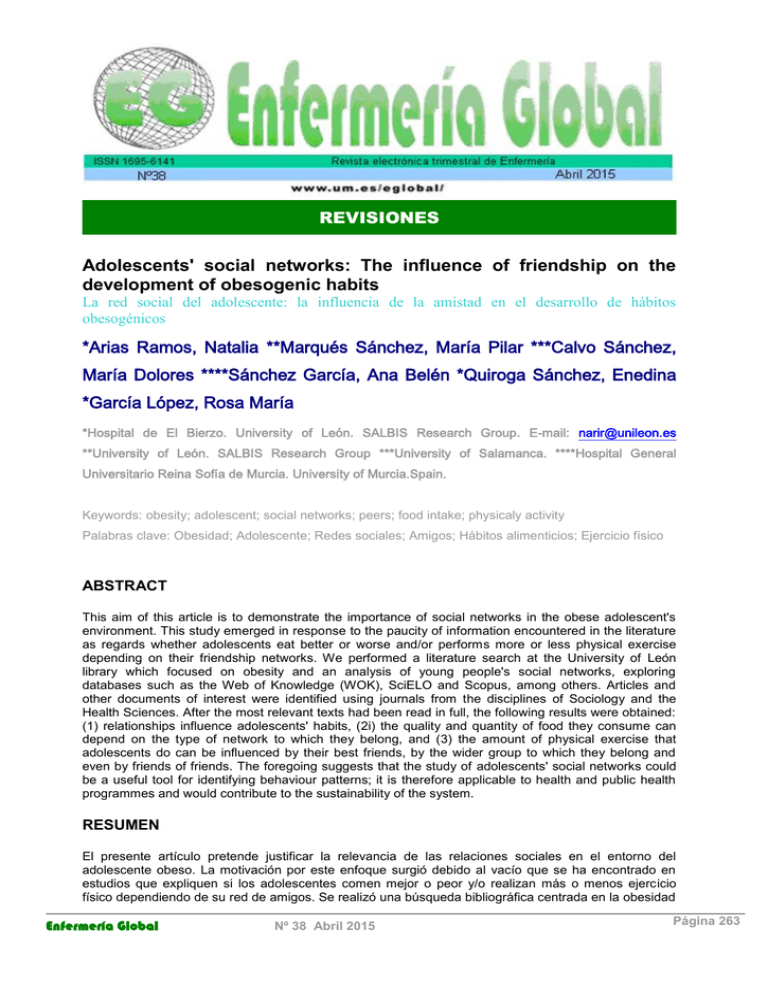
REVISIONES Adolescents' social networks: The influence of friendship on the development of obesogenic habits La red social del adolescente: la influencia de la amistad en el desarrollo de hábitos obesogénicos *Arias Ramos, Natalia **Marqués Sánchez, María Pilar ***Calvo Sánchez, María Dolores ****Sánchez García, Ana Belén *Quiroga Sánchez, Enedina *García López, Rosa María *Hospital de El Bierzo. University of León. SALBIS Research Group. E-mail: narir@unileon.es **University of León. SALBIS Research Group ***University of Salamanca. ****Hospital General Universitario Reina Sofía de Murcia. University of Murcia.Spain. Keywords: obesity; adolescent; social networks; peers; food intake; physicaly activity Palabras clave: Obesidad; Adolescente; Redes sociales; Amigos; Hábitos alimenticios; Ejercicio físico ABSTRACT This aim of this article is to demonstrate the importance of social networks in the obese adolescent's environment. This study emerged in response to the paucity of information encountered in the literature as regards whether adolescents eat better or worse and/or performs more or less physical exercise depending on their friendship networks. We performed a literature search at the University of León library which focused on obesity and an analysis of young people's social networks, exploring databases such as the Web of Knowledge (WOK), SciELO and Scopus, among others. Articles and other documents of interest were identified using journals from the disciplines of Sociology and the Health Sciences. After the most relevant texts had been read in full, the following results were obtained: (1) relationships influence adolescents' habits, (2i) the quality and quantity of food they consume can depend on the type of network to which they belong, and (3) the amount of physical exercise that adolescents do can be influenced by their best friends, by the wider group to which they belong and even by friends of friends. The foregoing suggests that the study of adolescents' social networks could be a useful tool for identifying behaviour patterns; it is therefore applicable to health and public health programmes and would contribute to the sustainability of the system. RESUMEN El presente artículo pretende justificar la relevancia de las relaciones sociales en el entorno del adolescente obeso. La motivación por este enfoque surgió debido al vacío que se ha encontrado en estudios que expliquen si los adolescentes comen mejor o peor y/o realizan más o menos ejercicio físico dependiendo de su red de amigos. Se realizó una búsqueda bibliográfica centrada en la obesidad Enfermería Global Nº 38 Abril 2015 Página 263 y el análisis de las redes sociales de los jóvenes a través de la Biblioteca de la Universidad de León, en diferentes bases de datos tales como Web of Knowledge (WOK), Scielo, Scopus, entre otras. Se obtuvieron artículos y otros documentos de interés utilizando revistas pertenecientes a las disciplinas de la Sociología y de las Ciencias de la Salud. Tras realizar la lectura de los textos más relevantes se pudo obtener los siguientes resultados: (1) las relaciones influyen en los hábitos de los adolescentes, (2) la calidad y la cantidad de comida puede depender del tipo de red que le rodea, y (3) el nivel de ejercicio físico que tiene un individuo se puede ver influenciado por sus mejores amigos, por el grupo en general que le rodea e incluso por los amigos de sus amigos. De todo ello se deriva, que el estudio de la red social del individuo puede ser una herramienta útil a la hora de visualizar los patrones de comportamiento, y por tanto, aplicable a los programas de salud y salud pública contribuyendo, de esta forma, a la sostenibilidad del sistema. . INTRODUCTIÓN It has become increasingly important to study all the factors that can contribute to weight gain, including social influence, given that the World Health Organization (WHO) now considers obesity in children and adolescents to be one of the most serious public health problems of the twenty first century (1). The onset of this nutritional disorder at such an early age is a cause for concern as it has been demonstrated that overweight children and adolescents are at higher risk of obesity in adulthood (2). Obesity directly impacts on the individual's quality of life, heightening the short- and long-term risk for conditions that increase morbidity, mortality and health spending, such as type II diabetes, cardiovascular disease, musculoskeletal disorders and some cancers, as well as provoking psychological conditions such as anxiety and depression (3). The high prevalence rates reported worldwide have prompted the development of various kinds of strategy; however, to date these have not yielded the desired results. This situation has led institutions and organizations with responsibilities in this area to implement new approaches aimed at reducing or halting this epidemic through the creation and promotion of policies which are sustainable over time, and which include all stakeholders involved in the fight against child and adolescent obesity (4). Consequently, Europe has developed new framework programmes for research and development that reflect this concern not only about obesity and overweight, but also other diseases related to a lack of healthy habits. Such is the case of the Horizon 2020 Programme, which aims through its three basic sections to address the most important problems for the general population. Specifically, and in the context of the present study, the section termed Societal Challenges includes a newly created strategy entitled "Health, Demographic Change and Wellbeing", the aim of which is to promote the health and welfare of all and to enhance disease prevention, including the problem of obesity and overweight (5). Before presenting the results of this literature review, which focused on a study of adolescents' social networks and the influence of these on certain obesity-related habits, it will be necessary first to discuss how the problem of overweight in adolescence is affected by social influence. Next, an description will be given of the Social Network Analysis (SNA) method, which can be used to quantify young people's relationships and thus obtain information on patterns of social behavior that favour obesity or not. Lastly, a series of studies will be discussed which have demonstrated that an adolescent's social environment exerts a considerable influence on eating habits, physical exercise and sedentary behaviour. Enfermería Global Nº 38 Abril 2015 Página 264 Overweight in adolescence, a problem substantially affected by social influence Overweight and obesity in adults and children is considered a serious multifactorial problem, the answer and solution to which does not lie in an individual's genetic makeup and personal characteristics alone (2). It seems that our social environment assumes particular importance as regards acquiring and maintaining over time attitudes and behaviours with a crucial impact on our health (6). The study by Cristakis and Fowler was groundbreaking in this respect because, among other findings of interest, these researchers demonstrated that adults presented a 57% probability of becoming obese if they had an obese friend (6). Adolescence represents a particularly important time to consider, as it constitutes a period of transition to adulthood in which physiological, psychological and social adaptations occur that may undermine the healthy habits acquired during childhood (7). To this may be added adolescents' lack of a sense of danger and inability to perceive the consequences of their behaviours (8). It is therefore a complex period during which subjects develop their self-esteem and self-concept (7) under a multitude of influences exerted by their network of friends and the society in general to which they belong and with which they are in constant contact. Thus, adolescents' behaviour may reflect a similar pattern to that of those close to them, in other words their social network, hence the importance of studying and analysing these networks in order to promote healthy behaviours (9). Obesity is an epidemic spread by people's social networks (6), and the way in which it is propagated in individuals of any age has been the subject of study from a psychological standpoint. It seems that overweight and obesity have become increasingly "normal" in children, adolescents and adults, favouring the adoption and maintenance of certain behaviours that promote weight gain. A study to determine whether obesogenic habits are the result of peer imitation or, in contrast, are provoked and/or stimulated by social facilitation or because of the imposition of social norms, did not reach a definitive conclusion (10). This approach, which seeks to identify a psychological basis as the cause of certain behaviours, suggests that the social environment has an influence which remains largely unexplored in scientific terms. The need to belong to a group and the fear of social stigma, especially during adolescence, both lead young people to modify habits and behaviours that were previously under the control of their parents, thus highlighting the importance of social relationships in adolescents' lives, the focal point of the present study. Social Network Analysis (SNA) and its application in the field of health An individual's social network acts as a dynamic structure that determines his or her behaviour in various aspects of life. A social network can be defined as a set of nodes and ties, the latter representing the existence or lack of a relationship between nodes (11) . The network encompasses a knitting relationships of relationships through which resources are exchanged, such as information, help and advice; however, for this to be possible it is necessary to establish ties of trust and friendship that facilitate achievement of the objective among the actors or nodes involved (9). Consequently, it is important to study the kind of resources transferred through the ties of friendship, by means of SNA. Enfermería Global Nº 38 Abril 2015 Página 265 SNA (12) is a method that quantifies relationships, facilitating an understanding of the dynamics of the contacts established between actors. This methodology is based on Graph Theory, in which other disciplines such as anthropology, sociology and psychology have also played a key role as regards interpretation of the relational data of the individuals comprising the network. This type of analysis provides information about the characteristics of the network to which individuals belong, such as network size, the subgroups that it contains (clusters), the degree of relationships the degree of betweenness and the proximity of the nodes or closeness, as well as the degree of influence on the acquisition of certain behaviours (eigenvector). In short, SNA yields a quantitative measurement of aspects which can sometimes be invisible. SNA has already been applied to the field of health, and it has been demonstrated that relationships determine various pathological processes (9). For example, studies have confirmed that social networks can accelerate the speed with which a disease may spread (13), exert an influence on certain infectious processes (14), increase the risk of contracting HIV (15) and promote habits that improve cardiovascular health (16), etc. The foregoing suggests that the social environment even exerts an influence on diseases that have reached epidemic proportions, and thus the same might be the case with obesity. In this regard, it has already been demonstrated that adolescents with a high body mass index display certain characteristics in their pattern of relationships within the network (17, 18), such as occupying a peripheral position and presenting a low degree of relationships, quite unlike the findings that have been reported in studies of smokers and/or alcohol users. They tend to choose other nodes who are also overweight as their friends. The consequent obvious conclusion is that obese adolescents have fewer relational resources with which to tackle the goal of losing weight. This tendency to choose similar individuals as friends has been defined in sociology as homophily (19) . This concept refers to the phenomenon whereby an individual establishes relationships according to similarity in aspects such as age, gender, certain habits, ways of thinking or other distinguishing characteristics, a trait that is typical of social selection processes at all ages. In short, through processes such as homophily, adolescents establish ties with other similar individuals, forming networks that if studied and analysed might yield data of use in modifying habits that are harmful to their health. MATERIALS AND METHOD To perform this study, we conducted a specific search of documents such as crosssectional and longitudinal research studies, literature reviews published mainly in English and other relevant documents focusing on Social Network Analysis and obesity in children and adolescents. This literature search was conducted at the University of León library, using the following databases: the Web of Knowledge (WOK), SciELO and Scopus, among others. The most frequently consulted journals belonged to various disciplines, such as Paediatrics, Psychology, Public Health and the Social Sciences. The different databases were searched using a number of key words in both Spanish and English, of which the most frequently employed were: obesidad (obesity), adolescente (adolescent), redes sociales (social networks), amigos (friends), colegas (peer), hábitos alimenticios (food intake), ejercicio físico (physical activity) and comportamiento sedentario (sedentary behaviour). The most relevant articles and Enfermería Global Nº 38 Abril 2015 Página 266 documents identified in this review were obtained in April and May 2014, seeking to base the present paper on the most recently published literature. To narrow the search, only full-text documents published since 2000 were used, although earlier texts and documents that due to their importance served as a reference have also been employed occasionally. RESULTS In this section we present the most relevant results extracted from articles of particular interest included in this literature review. These show that young people's social environment has a considerable capacity to influence health-related behaviours, and more specifically obesity, such as food intake, physical exercise and sedentary habits. Table 1 below shows the principal variables studied and main results obtained by the authors. Note that the results presented here were obtained in studies on adolescents, the group studied in this paper, and thus samples consisting of children and adults were excluded. Table I. Empirical studies demonstrating the influence of social networks on nutrition and physical exercise in adolescents. Source: by the authors. Author Influence of environmental factors on food intake and choice of beverage during meals in teenagers: a laboratory study. Péneau et al. (20) Journal British Journal of Nutrition Year published 2009 Variables studied The authors assessed food intake (main course, dessert, water, juice and soft drinks) under controlled conditions in four different situations: alone, in groups of three, watching television alone and listening to music alone. Main results Unlike adults, for adolescents, eating in a group facilitates social inhibition rather than the contrary, and the presence of external sources of distraction (watching television or listening to music) does not stimulate consumption. Article Obesity-related behaviors in adolescent friendship networks. Author De la Haye et al. (21) Journal Social Networks Year published 2010 Variables studied The authors assessed intake frequency for certain high-calorie foods, amount and frequency of physical activity, time spent in front of display screens, ties of friendship with classmates and body mass index (BMI). Article Enfermería Global Type of study Type of study Nº 38 Abril 2015 Cross-sectional Cross-sectional Página 267 Main results Same-sex groups engaged in similar levels of organised physical activity. In an analysis of friendship groups by sex, female groups engaged in a similar level of activities involving display screens. In contrast, groups of male friends engaged in similar levels of consumption of high-calorie foods. Regarding the role that popular students occupied in networks formed at school, they were observed to exert an influence on some healthy behaviours. Article Author Weight-related behavior among adolescents: the role of peer effects. Ali et al. (22) Journal Plos One Year published 2011 Variables studied The authors studied participation in regular physical activity and active sports. They also studied the hours adolescents spent watching television/videos and the time they spent sleeping. As regards eating habits, subjects were asked about breakfast, how often they ate at fast food restaurants, daily intake of fruit and vegetables, consumption of high-calorie snacks and lastly, BMI. Main results Significant evidence was obtained that friends influenced participation in sports and regular physical activity, as well as the frequency of fast food consumption. However no evidence was obtained regarding influence on breakfast, hours spent watching television or asleep, or consumption of snacks, fruit and vegetables. Article Author Relationship between adolescents’ and their friends’ eating behaviors: breakfast, fruit, vegetable, whole-Grain, and dairy intake. Bruening et al. (23) Journal Journal of the Academy of Nutrition and Dietetics Year published 2012 Variables studied Adolescents' consumption of certain foods (breakfast, fruit and vegetables, whole grains and dairy products) was related to intake of these foods by the subject's group of best friends and his or her group of friends or peers. Main results A positive association was obtained between adolescents' intake of breakfast, whole grains and dairy products, and both groups of friends. However, vegetable intake was only associated with the group of best friends while no association was found for fruit consumption. Enfermería Global Type of study Type of study Nº 38 Abril 2015 Longitudinal Cross-sectional Página 268 Author The association of objectively determined physical activity behavior among adolescent female friends. Schofıeld et al. (24) Journal Research Quarterly for Exercise and Sport Year published 2007 Variables studied The relationship was determined between the number of steps taken per day, measured by means of a pedometer, and a student's friendship with her three best friends, whom she nominated, three reciprocal friendships and three non-reciprocal friendships. Main results It was observed that when the friendship was reciprocal, there was a strong relationship between the adolescent's level of physical activity and that of her friends, compared with non-reciprocal friendships. Article Author Better with a buddy: influence of best friends on children’s physical activity. Jago et al. (25) Journal Medicine & Science in Sports & Exercise Year published 2011 Variables studied Accelerometers were used to measure load and intensity of physical activity (mean accelerometer counts per minute (CPM) and mean minutes of moderate-to-vigorous intensity physical activity per day (MVPA)) and these were related to an adolescent and his or her friends at school, also asking about aspects related to participation in physical activity. The weight and height of each subject was also recorded in order to calculate their BMI. The results indicated that both female and male adolescents presented higher physical activity levels if they performed physical activity with their best friends. Article Main results Type of study Type of study Cross-sectional Cross-sectional Author How physical activity shapes, and is shaped by, adolescent friendships. De la Haye et al. (26) Journal Social Science & Medicine Year published 2011 Variables studied This study explored ties of friendship in class and related these to participation in physical activity (frequency and amount) and knowledge of the subject (attitude towards sport, peer norms, perceived control, self-efficacy and intention to engage in physical exercise). Article Enfermería Global Type of study Nº 38 Abril 2015 Longitudinal Página 269 Main results It was concluded that adolescents tend to form ties of friendship with people holding similar attitudes towards physical activity, and subsequently, i.e. after having chosen their friends, mimic the behaviour of their peers. Article Author School-based friendship networks and children´s physical activity: A spatial analytical approach. Macdonald Wallis et al. (27) Journal Social Science & Medicine Year published 2011 Variables studied An accelerometer was used to measure load and intensity of physical activity (CPM and MVPA) and subjects were asked about self-efficacy in performing physical activity. Subjects' weight and height were recorded in order to determine each individual's BMI and an association was subsequently sought between an adolescent and his or her four best friends regarding their geographical location. Main results The amount of physical activity that adolescents performed was positively and significantly related to that performed by their immediate friends and their secondary friends, separated by one degree of distance. Type of study Cross-sectional DISCUSSION Social relationships and their influence on food intake Together with physical activity, eating habits comprise one of the determining factors which most contribute to the emergence of overweight and obesity. Through their network of friends and peers, adolescents may be influenced as to the amount and type of food they eat. Good nutrition ensures proper development in children and guarantees their long-term health during childhood and adolescence alike. Good eating habits and a balanced diet are considered the key to achieving the goal of good health for adolescents (28). At present, young people's eating habits are changing, and some healthy behaviours are being replaced by others of a more harmful nature as a consequence of the influence exerted by the social network to which they belong. The amount of food ingested can be influenced by a multitude of factors, but particularly by an individual's social environment. In adult subjects, it has been shown that people eat more food when they are in the company of others, compared to when they eat alone. This is probably because mealtimes last longer as a result of social interaction, especially when accompanied by family and friends, prompting an atmosphere of relaxation and lack of inhibition (29). As with adults, a study of pre-school age children conducted by Lemung and Hillman (30) revealed an association between Enfermería Global Nº 38 Abril 2015 Página 270 group size and the amount of food eaten. Specifically, the group with most children ate a larger quantity, more quickly and for longer, showing less interaction between them compared with the smaller group. However, in adolescence, the nature of the tie with the person or people with whom the food is shared assumes greater importance. The amount of food ingested varies depending on whether subjects eat with family members or not. A study by Péneau revealed that less quantities were eaten in the company of non-family members (individuals of the same age, from the same neighbourhood, who might be classmates) than when subjects ate alone, watching television or listening to music (20) . In the same vein and probably due to fear of social stigma and the desire to make a good impression, similar effects of variability were observed depending on the child's weight and that of his or her peers. Thus, as with the effect on adolescents, it was observed that the overweight children studied, who were aged between 6 and 10 years old, ate more when they were alone than when they were in the company of strangers, unlike normal weight individuals, who ate the same amount regardless of the tie (31). With regard to the type or quality of food, De la Haye (21) reported interesting results with regard to popular students. It was found that adolescent males who consumed high-calorie snacks tended to be more popular than those who ate healthier food, and this effect was not only observed in relation to the quality of food, but also as regards other healthy behaviours such as physical exercise. Furthermore, it was even observed that depending on what they ate, adolescents might wield more leadership and become a role model for others, thus demonstrating the social influence that these students exerted, especially within their friendship networks. Friendship networks also seem to influence the type of food consumed, whether fast food, sweets and salty snacks, high-calorie drinks, fruit and vegetables or breakfast habits (21-23). In their study, Ali et al. (22) found a positive association between an individual and his or her friends regarding the use of fast food restaurants, while in a similar vein, De la Haye et al. (21) found a significant correlation between consumption of snacks and fast food. Bruening et al. (23) classified friendship as a "group of friends" and "best friends", and observed that there could be different influences depending on the intensity of the tie. They found a significant association between the group of "best friends" and adolescents' intake of breakfast, whole grains, dairy products and consumption of vegetables, but not fruit (23). The foregoing highlights the importance of the social environment as regards the quantity and quality of food individuals consume. Friends, family, and peers are all important. However, there is a paucity of studies on adolescents using specific methods to measure the social environment; hence, SNA could prove a useful tool for future research in this context. The influence of the social environment on adolescents' participation in physical activity The literature discussed in this section indicates that adolescents' social environment can exert a positive or a negative effect on adolescents' participation in physical activity and active sports. It is important to note that in recent years, the time previously devoted to physical activity and sport has been replaced by time spent with display devices such as televisions, computers, video-game consoles and mobile Enfermería Global Nº 38 Abril 2015 Página 271 phones (32). In their study of school children aged between 4 and 15 years old, Rodríguez-Hernández et al. demonstrated that obesity and a sedentary lifestyle are factors that are to a large extent associated with worse mental health, and they associated sedentary behaviour with problems in social relationships with peers and other behavioural problems, whereas they related a healthy weight with psychological wellbeing and linked physical activity to a good state of child health (33). Guidelines recommend that children and adolescents aged between 6 and 17 years old should do at least 60 minutes a day of moderate-to-vigorous physical activity (MVPA) of an aerobic nature, as well as activities to strengthen muscles and bones at least three times a week. In the same vein, recommendations for time spent on sedentary activities are that this should not exceed 2 hours per day (34). MartinezLopez et al. have provided a truly worrying figure in relation to these recommendations in their study on the Spanish population, reporting that 49% of the surveyed population aged between 12 and 16 years old declared spending more than two hours a day watching television, while 40% reported avoiding walking to destinations (35). In the context of relationship networks, readers may wonder how adolescents exert an influence on their peers as regards participation in exercise and active sport or sedentary habits. Similarly to eating behaviour, the degree and reciprocity of friendship can influence adolescents' participation in physical activity and sports in different ways. A reciprocal friendship can be defined as a situation in which two people perceive each other as friends, whereas a non-reciprocal friendship is one where one of the two parties does not perceive the other as a friend (24). Schofield et al. analysed friendship according to this variable and demonstrated that reciprocity of friendship is an important factor to consider in the study of levels of physical activity in female adolescents. They found that the amount of exercise that young female adolescents engaged in varied depending on the nature of their friendship with their nominated friends, whereby reciprocal friendship could exert more influence as regards changing behaviour (24). In agreement with this finding, other authors have obtained similar results in early adolescents separated by sex, finding that boys who have active best friends devote more minutes per day to MVPA, participating in a large amount of exercise, while girls who frequently engage in physical activity with their best friends present higher levels of physical activity when compared with girls who do so less frequently (25). Other studies have delved further, attempting to determine the reasons for this choice. Thus, De la Haye explored whether people select friends with similar physical activity behaviours, or if instead it is peer pressure that provokes changes in people's level of physical activity. It was concluded that children and adolescents were more likely to develop friendships with others presenting similar physical activity behaviours, and that subsequently, i.e. after having chosen these friends, they tended to mimic their peers' behaviour (26). However, it is not only best friends who exert an influence on adolescents. The entire group of friends to which an adolescent belongs seems to generate similar effects with respect to physical activity and sedentary behaviour. Thus, in a study assessing these variables, Ali et al. (22) found an association between adolescents and their friends as regards participating in active sport and regular exercise. Delving further, Macdonald Wallis et al. found that not only did best friends and close peers exert an influence, but that there was also a correlation between young people's Enfermería Global Nº 38 Abril 2015 Página 272 behaviour and more distant friendships, in other words, with a more distant degree of friendship corresponding to the friends of their friends (27). The findings related to sedentary habits, and whether friendship influences the spread of certain behaviours, are more disparate. When analysing sedentary variables, the same authors cited above found no correlation as regards inactive habits such as watching television (22). Their interpretation of these results was that this was because such activities were engaged in at home and were not habits that were usually shared with friends (22). Other authors have also failed to find clear evidence of the spread of behaviour among friends as regards certain sedentary habits. In terms of gender, sex-related differences have been observed between boys and girls in the use of display devices in their spare time. Among males, differences were found between the individual and his friends in 2 of the 3 networks studied, whereas similar behaviour regarding this same variable was observed in female networks (21). CONCLUSIONS In general, adolescents' friendship networks, peer groups and classmates exert an influence that can modify both healthy and unhealthy behaviours in areas related to the study of obesity. Addressing the problem from the perspective of Social Network Analysis can provide a new approach to actions in intervention strategies, and contribute to mitigating this global epidemic. There is a need for multifactorial solutions proposed by multidisciplinary teams studying young people within their community rather than individually. The study of the social structures surrounding individuals, their ties with others, and leadership within the group, plays a fundamental role in addressing adolescent obesity. REFERENCES 1.Organización Mundial de la Salud. Estrategia mundial sobre régimen alimentario, actividad física y salud. Sobrepeso y obesidad. Causas. Diponible en: http://www.who.int/dietphysicalactivity/childhood_why/es/. [Consultado el 7 de mayo de 2014]. 2. Koehly LM, Loscalzo A. Adolescent obesity and social networks. Prev Chronic Dis 2009; 6(3): A99. 3. Organización Mundial de la Salud. Diet, nutrition and the prevention of chronic diseases. Report of a Joint FAO/WHO Expert consultation. Ginebra: OMS; 2003. WHO Technical report series 916. 4. Thompson-Reid PE. Engaging and mobilizing community members to prevent obesity among adolescents. Prev Chronic Dis 2009; 6 (3): A100. Disponible en http://www.cdc.gov/pcd/issues/2009/jul/08_0259.htm . Consultado el [8 de mayo de 2014 ] 5. European Commission. Horizon 2020. The EU Framework Programme for Research and Innovation.. Disponible en: http://ec.europa.eu/programmes/horizon2020/,http://www.eshorizonte2020.es/. [Consultado el 1 de abril de 2014] 6. Christakis N, Fowler J. The spread of obesity in a large social network over 32 years. N Engl J Med 2007; 357: 370-9. 7. Jiménez C, Gálvez E, Colomer T. Autoimagen corporal, comportamiento alimentario y estilo de vida en adolescentes. Metas de enfermería 2011; 14 (3): 69-75. Enfermería Global Nº 38 Abril 2015 Página 273 8. Esposito L, Fisher JO, Mennella JA, Hoelscher DM, Huang TT. Developmental perspectives on nutrition and obesity from gestation to adolescence. Prev Chronic Dis 2009; 6 (3): A94. Disponible en http://www.cdc.gov/pcd/issues/2009/ jul/09_0014.htm . Consultado el [9 de julio de 2014]. 9. Marqués MP, Fernández R, Cabrera A, Muñoz-Doyagüe MF, Llopis J, Arias N. La sostenibilidad del sistema sanitario desde una perspectiva de redes: Una propuesta para la promoción de los hábitos saludables y el apoyo social. Rev Esp Salud Pública 2013; 87 (4): 307-15. 10. Salvy SJ, de la Haye K, Bowker J, Hermans CJR. Influenceof peers and friends on children´s and adolescent´s eating and activity behaviors. Physiol Behav 2012; 106:369-78 11. Brass DJ, Galaskiewicz, Greve HR, Tsai W. Taking stock of networks and organizations: A multilevel perspective. Acad Manage J 2004; 47 (6): 795-817. 12. Wasserman S, Faust K. Social network analysis: Methods and applications, Cambridge: Cambridge University Press; 2007. 13. Hollm-Delgado MG. Molecular epidemiology of tuberculosis transmission: contextualizing the evidence through social network theory. Soc Sci Med 2009; 69:747-53. 14. Gayen K, Reaside R. Social networks and contracepcion practice of women in rural Bangladesh. Soc Sci Med 2010; 71: 1584-92. 15. Schneider J, McFadden R, Laumann E, Kumar P, Gandham S, Oruganti G. Candidate change agent identification among men at risk for VIH infection. Soc Sci Med 2012; 75: 1192-201. 16. Strully K, Fowler JH, Joanne M, Emelia M, Levy BD, Christakis N. Aspirin use and cardiovascular events in social networks. Soc Sci Med 2012; 74: 1125-29. 17. Mulassi AH, Borracci RA, Calderón JGE, Vinay P, Mulassi M. Redes sociales de tabaquismo, consumo de alcohol y obesidad e adolescentes escolarizados de la ciudad de Lobos. Arch Argent Pediatr 2012; 110(6): 474-482. 18. Valente TW, Fujimoto K, Chou CP, Spruijt-Metz D. Adolescents affliations and adiposity: A social network analysis of friendship and obesity. Journal of Adolescent Health 2009; 45: 202-204. 19. McPherson, J.M.; Smith-Lovin, L.; Cook, J. Birds of a feather: homophily in social networks. Annual Review of Sociology 2001; 27:415–444 20. Péneau S, Mekhmoukh A, Chapelot D, Dalix A, Airinei G, Hercberg S, et al. Influence of environmental factors on food intake and choice of beverage during meals in teenagers: a laboratory study. Br J Nutr 2009; 102:1854-9. 21. De la Haye K, Robins G, Mohr P, Wilson C. Obesity-related behaviors in adolescent friendship networks. Soc Networks 2010; 32: 161-67. 22. Ali MM, Amialchuk A, Heiland FW. Weight-related behavior among adolescents: the role of peer effects. PLoS One. 2011;6(6):e21179. 23. Bruening M, Eisenberg M, MacLehose R, Nanney MS, Story M, Neumark-Sztainer D. Relationship between adolescent´s and their friend´s eating behaviors: breakfast, fruit, vegetable, whole grain and dairy intake. Journal of the academy of nutrition and dietetics 2012; 112(10): 1608-13. 24. Schofıeld L, Mummery WK, Schofıeld G, Hopkins W. The association of objectively determined physical activity behavior among adolescent female friends. Res Q Exerc Sport. 2007;78(2):9-15. 25. Jago R, Macdonald Wallis K, Thompson JL, Page AS, Brockman R, Fox KR. Better with a buddy: influence of best friends on children’s physical activity. Med Sci Sports Exerc. 2011;43(2):259-65. 26. De la Haye K, Robins G, Mohr P, Wilson C. How physical activity shapes, and is shaped by, adolescent friendships. Soc Sci Med. 2011;73(5):719-28 Enfermería Global Nº 38 Abril 2015 Página 274 27. Macdonald-Wallis K, Jago R, Page AS, Brockman R, Thompson JL. School-based friendship networks and children´s physical activity: A spacial analytical approach. Soc Sci Med. 2011;73:6-12. 28. Estrategia NAOS. Disponible en: http://www.naos.aesan.msssi.gob.es/csym/nutricion_saludable/recomendaciones/. [Consultado el 13 de abril de 2014]. 29. De Castro JM. Family and friends produce greater social facilitation of food intake than other companions. Physiol Behav 1994; 56: 445-55. 30. Lemung JC, Hillman KH. Eating in larger groups increases food consumption. Arch Dis Child 2007;92:384–837. 31. Salvy SJ, Coelho JS, Kieffer E, Epstein LH. Effects of social contexts on overweight and normal-weight children´s food intake. Physiol Behav 2007; 92(5):8406. 32. Martí S. Actividad física, sedentarismo frente a pantallas y su relación en adolescentes [tesis]. Las Palmas de Gran Canaria: Universidad de las Palmas de Gran Canaria; 2011. 33. Rodríguez-Hernández A, de la Cruz-Sánchez E, Feu S, Martínez-Santos R. Sedentarismo, obesidad y salud mental en la población española de 4 a 15 años de edad. Rev Esp Salud Pública 2011; 85: 373-382. 34. Moreno LA, Gracia-Marco L y Comité de Nutrición de la Asociación Española de Pediatría. Prevención de la obesidad desde la actividad física: del discurso teórico a la práctica. An Pediatr (Barc) 2012; 77(2): 136.e1-136.e6. 35. Martínez-López EJ, Cachón J, Moral JE. Influences of the school and family and family context in the adolescent´s physical activity. Special attention to the obese pupil. J Sport Health Res 2009; 1(1): 26-45. Received: December 14, 2014; Accepted: February 9, 2015 ISSN 1695-6141 © COPYRIGHT Servicio de Publicaciones - Universidad de Murcia Enfermería Global Nº 38 Abril 2015 Página 275
